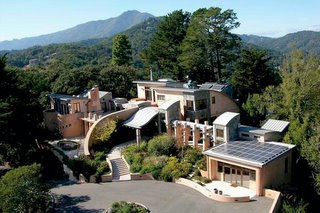Marin's 'greenest' mansion

From MarinIJ:
Marin's 'greenest' mansion: Estate touted as zenith of ecologically correct homes
Beth Ashley
Marin Independent Journal
This hilltop site in Corte Madera was once home to the late rock impresario Bill Graham.
Today it holds what its designer says is probably the largest "green" - ecologically correct - house in America.
Designed by Inverness architect Sim Van der Ryn and under construction for more than five years, the 15,000-square-foot house was built for owner Michael Klein, a passionate environmentalist and board member of the Rain Forest Action Network. It replaces the Graham house, which has been razed.
Hidden behind wrought-iron gates at 800 Corte Madera Ave., invisible from the road, Guitar House, as it's called, is stunningly graceful, with 40 columns embracing an indoor-outdoor arcade/gallery and two curving entry staircases made of recycled stone from villages in central China.
Most of the building material is recycled or uniquely created; columns and other structural elements are made from rammed earth (strengthened by fly ash coal residues) whose strengths were lab-tested just for the Klein house.
Van der Ryn says lab research is part of the reason the house took so long to create - "longer than the Hoover Dam," Klein told the New York Times.
Its skeleton was finished in 2000; it was occupied two years later.
It will be open to the public for the first time on Jan. 21 when a Marin committee of grassroots political activists hosts a fund-raiser for Vermont Rep. Bernie Sanders, an independent candidate for the Senate seat to be vacated by Sen. Jim Jeffords, also an independent.
Visitors will see a home that is not only innovative but beautiful - composed of 18-foot-thick walls in a soft terra cotta color and graced with curved roofs, staircases and a low surrounding wall filled with plantings.
The entry staircase levels into a walkway that bridges a small aerated pond filled with carp.
The house inside is sculptured with light. Sunlight warms the limestone tile floors, which in turn radiate heat when the sun goes down.
Van der Ryn, 70, is a pioneer in "green" architecture, a concept that has come into vogue long since he became its most visible advocate. He likes to incorporate elements of nature in all his buildings - water, fresh air, sunlight - and thinks all buildings should have visual meters so occupants can see the extent of the resources they're using.
"Buildings use about half of our natural resources," he says. "People should understand that. In urban areas, for instance, most people have no idea where their water comes from."
He taught his ideas for years at the University of California at Berkeley and served under former Gov. Jerry Brown as state architect in the mid-'60s, creating a series of energy-efficient state buildings.
Van der Ryn was the visionary who more than 30 years ago proposed a Solar Village on former government land at Hamilton Field, an idea too ahead of its time to catch on. But in the years since, he has served dozens of clients with his nature-savvy designs and has inspired a band of ground-breaking adherents.
Klein, who made his fortune in the high-tech and data communications industry, approached Van der Ryn in 1995 to build a home employing the best in environmental concepts and new technology.
Chance of a lifetime
The architect jumped at the chance. "You don't often get free rein to do something like this. It was a once-in-a-lifetime opportunity to build something of great durability, beauty and craftsmanship."
His initial plan, quickly approved by Corte Madera city officials, was for a somewhat guitar-shaped house, referencing Klein's love of guitar-playing - he's a fine amateur guitarist, says Van der Ryn, and the founder of Novato-based Modulus Guitars, a guitar manufacturing company.
Plans called for a large "music room" where Klein could strum and which would double as a gathering place for family and friends. The music room, which forms the body of the "guitar," is now also a home theater, whose screen and projector descend from the ceiling. (The neck of the guitar is the long colonnade.)
Plans for the house expanded during construction - "every day something new happened" - but the basic guitar shape remains.
"There really aren't that many rooms," says Van der Ryn: three children's bedrooms on a second story above the music room, a master suite (and second bedroom) above the living-dining main room.
Large rooms
The large main room was designed to accommodate retreats for boards of environmental organizations Klein is involved in, Van der Ryn says. The room, which features a large curved bar, commands a broad view of surrounding lands, with San Francisco visible beyond.
The home now includes a giant kitchen, perhaps built to accommodate Klein's then-wife Roxanne, owner/executive chef of the much-publicized "raw-foods" restaurant called Roxanne's that closed last year in Larkspur. The kitchen includes several pantries and a gigantic work island, according to one observer "the size of most tract-home bedrooms."
(Klein and Roxanne have since divorced and, according to Van der Ryn, he is honeymooning with new wife Diandre Douglas, ex-wife of actor Michael Douglas.)
Klein wanted a house that would use only reclaimed wood and a minimum of cement. "The manufacture of Portland Cement worldwide accounts for 6 to 8 percent of global warming," Van der Ryn says.
Some of the wood in the house is from buildings torn down at the San Francisco Presidio.
Ancient technique
The non-cement elements were adaptations of an ancient technique called rammed earth, in which low-grade soil was placed in forms and compressed with hammers. In modern times, rammed earth was strengthened with cement; in the Klein house it was strengthened with fly ash, a byproduct of coal-fired power plants.
The soil used was reddish-toned quarry waste from Napa - "it's like decomposed granite," says Van der Ryn. Attempts to use soil from the Corte Madera site were abandoned because its composition, mostly sandstone, "didn't have the strength."
A striking feature of the house is the east-west colonnade that runs from a solar-roofed yoga room at one end to the music room at the other and is positioned for maximum light.
Because of the light, the interior is strikingly simple, needing little adornment.
"The bones of the structure are beautiful," says Van der Ryn.
Challenges
Construction work was done by Red Horse Constructors, a San Rafael firm headed by David Warner of Fairfax, specialists in residential jobs (including sound studios for rock musicians).
Warner says his biggest challenge was preparing the "skeleton" of the house, which included testing of the rammed-earth elements (and the sprayed-earth walls). Sample pieces were tested on a seismic shaker table at UC Berkeley.
"Building the house was a career-building event," he says. "It's not often that one gets all the variables on one spot and you are doing what you have wanted to do for your whole life."
The building is "the embodiment" of sustainable technology, he says, citing geothermal well systems that make it possible to heat and chill the limestone floors. "This home sets the standard."
Beginning
Warner's first task was to raze the old Graham home. The debris was used in a variety of ways - concrete was pulverized and added to the hammered-earth mix; wooden parts were used in laminated beams. Leftover pieces were donated to Habitat for Humanity.
Cost for the project? Warner laughs. "I can't tell you that." It would be fair to say "in the multi-millions."
The house has an assessed value of $17.8 million, according to the Marin County assessor's office.
The property is maintained by caretaker Saul Gonzalez and two other full-time workers.
Gonzalez, who superintends several other houses in Marin, calls the Klein house "an incredible place to work." Taking care of the extensive organic gardens, he says, "has taught me so much about Mother Nature." He now incorporates organic practices at his home garden in Novato.
For three years Gonzalez worked on the site for Graham, who died in 1992. In the media room at Guitar House there is a large picture of a Bill Graham concert in the '60s, which Gonzalez saved and gave to Klein. The picture hangs near three painted portraits of Jerry Garcia.
Guests at the Jan. 21 event will be able to visit most of the downstairs rooms.
Van der Ryn says he wishes more people could visit the home, to experience its innovations in green techniques and construction technology. "It is a house that is married to its site," he says. "It has an aura of peace and permanence."



1 Comments:
Former employee of marin mfg.[structural steel] I had the pleasure to work with rich of redhorse construction and crew.I was the guy that welded all those beam connection plates,fabrication of the rectangular tube steel rolled at two different radi to form an "s" for a yoga room.I have also worked on the stainless steel embeds for the exterior stairs,steel roof trusses and more.The finished home is remarkable and I am proud to have had chance to contribute to the project. How about some pictures of the outside fireplace.Rocket RICK the weldin' fool
Post a Comment
<< Home